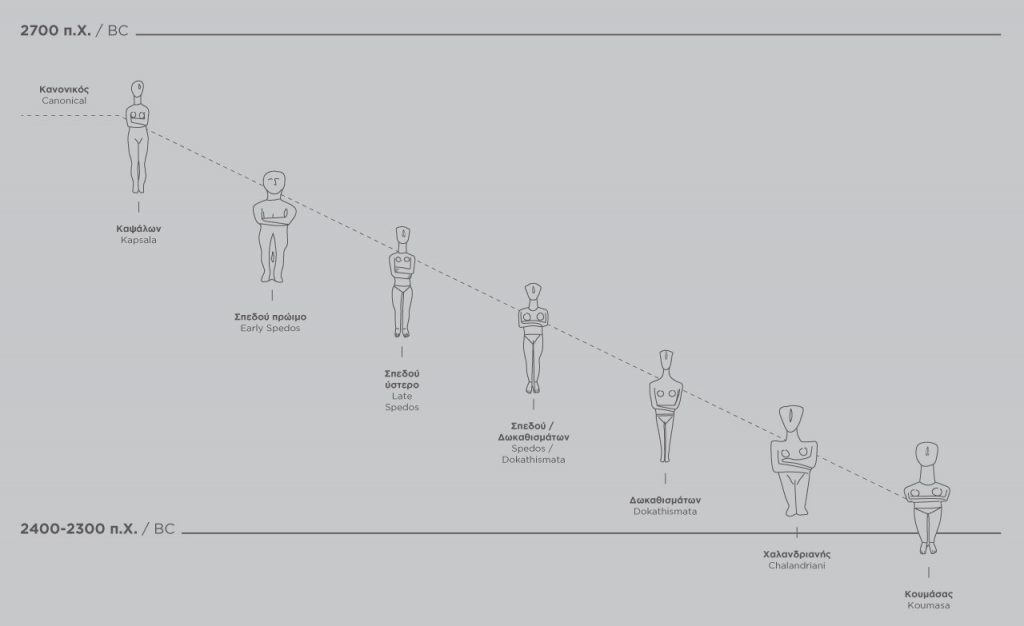Marble figurines are the most impressive creations of Cycladic art. They usually represent nude female figures with the arms folded above the abdomen (normally the left arm resting upon the right one), slightly flexed knees and a barely uplifted backward-slanting head. This type has been dubbed “canonical” by specialist scholars, because it accounts for the overwhelming majority of figurines sculpted in the Early Cycladic II period (2800-2300 BC), when Cycladic art was at its zenith. The “canonical” type includes several varieties, which have been named conventionally after the find-spot where they were first identified (Kapsala, Spedos, Dokathismata, Chalandriani, Koumasa; those varieties differ from each other only in stylistic details. “Canonical” figurines vary in size from miniature examples to almost life-size sculptures, but most of them are about 40 cm. high.
Some figurines of the transitional Early Cycladic I-II period, on which the above traits are not fully elaborated, are called “pre-canonical”. Earlier examples include two Early Cycladic I types which are named after the cemeteries where they were first found (Plastiras and Louros); in the Plastiras types, the human form is still rendered in a way reminiscent of Late Neolithic examples, while in the Louros type the artists prefer much more abstract forms. A series of later figurines, which clearly deviate from the strict stylistic rules of the Early Cycladic II period (mainly in the positioning of the legs and arms but also in the overall appearance of the human form) are referred to as “post-canonical”.
In addition to these rather “naturalistic” figurines, there are also several examples in which the female figure is represented in a highly schematic manner. The best-known among them are “violin-shaped” figurines of the Early Cycladic I period, so named for obvious reasons. These figurines are usually small, rarely exceeding 15-20 cm. Schematic examples are also known from the Early Cycladic I period but are very different in form.
The male figure is rarely represented in Cycladic art. Most frequently it appears in the form of a seated figurine, a musician (in the earlier part of the Early Cycladic II period) or a hunter/warrior (at the end of the same period). Male figurines in the “canonical” standing position are extremely rare. We do know, however, of a few standing males in the Plastiras type of the Early Cycladic I period.
Last, there is a small number of unusual examples representing various groups of figures (e.g. “double” figurines with one female standing on top of larger one). Those figurines date to the most productive period of Cycladic sculpture (Early Cycladic II).
The interpretation of the abstract motifs which were painted on the face and body of several figurines is a contested issue. Some scholars believe that they represent instances of body piercing or painted decoration for particular social or ritual occasions. Others believe that they were status symbols. According to another theory, they were meant to express different attributes of the represented figure. It has even been theorized that they functioned as characteristic symbols of a common cultural or social identity. This discrepancy of approaches should not come as a surprise, since the study of painted motifs on Cycladic figurines is still at an early stage.
We should stress that most painted figurines belong to the so-called “canonical” type of the Early Cycladic II period (2800-2300 BC), although we have instances of coloured decoration in earlier types, too, mainly the violin-shaped figurines and a few examples from the Plastiras and Louros types. The practice seems to die out at the final stages of EC II, when the colour gives way to relief decoration.

